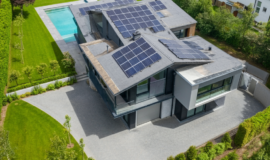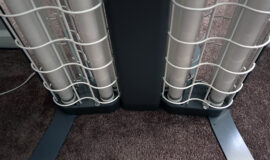Floatovoltaics – Solar Energy on Water
Solar energy plays a leading role in the movement towards greenhouse gases reduction. In the last years we notice a huge market growth, new PV solutions and trends in installations. But in some countries, land recourses are limited for bigger ground-mounted PV systems and not all rooftop areas (may they be in housing, commercial or industrial) are suited for rooftop solar solutions. Because of
that, alternative solutions are developed such as façade, floatovoltaics, submerged etc. This article is concentrated only on floatovoltaics and how they can be a suitable solution for PV that can improve their efficiency, land use and water management.
Floatovoltaics are a new concept of solar PV systems which are made to float on the water (so the name indicates) by using various floats such as mooring, pontoon etc. Like the conventional PV systems based on land, floatovoltaics have components like solar panels, power converters, fuse boxes and electrical storage systems like batteries or other storage units. Apart from these, the floating PV systems are constructed with other extra components.
So, a floating solar PV system contains:
– A floating system – A floating body (structure and a floater), which enables the installation of PV modules on water
– A mooring system – Used for adjusting the PV system to changes in the water while maintaining their position
– Underwater cables – Used for transferring the generated power from the PV modules to the
substation on land
– A PV system – PV modules installed on top of the floating system, inverter, controller, fuse box, substation etc.
Advantages of floating photovoltaics
The implementation of floatovoltaic systems has a number of advantages:
– Improved Energy Efficiency
The performance of a photovoltaic system depends on various factors, among which the temperature is a major one. PV panels lose a certain percent of their effectiveness with increasing panel temperature. With the implementation of a floatovoltaic system, both panel and ambient temperatures can be reduced. The cooling effect of water on the floatovoltaics leads to an increase in their efficiency.
– Reduction of Evaporation
By placing the floatovoltaic on a water body, they play a role in the reduction of evaporation of that water body. This is an especially important benefit for the countries where water supplies are limited.
– Reduction in Panel Soiling
Because the solar panels are placed on a water surface, far away from sources of dirt and dust, the installation reduces soiling, reducing the need for surface cleaning. Also, the closeness to water enables an easier way of cleaning the modules.
– No Loss of Valuable Land Space
Another advantage of this type of solar PV systems is that they don’t require any land space. Most of these systems are placed on unused space on water bodies such as drinking water reservoirs and hydroelectric dam reservoirs. This is also considered a great advantage in the countries where land values are high.
This article introduces the new concept of solar PV installation over a water body – the parts which it contains and the possible benefits. With land resources becoming more and more limited, who knows, maybe this will prove to be a reasonable solution in the following years for a lot of countries.





